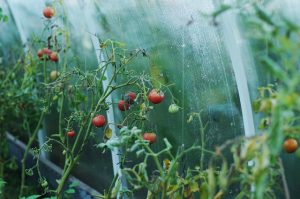
Hello! I always tried to keep a small greenhouse on the plot, which from year to year pleased with good crops.
But a couple of years ago, my whitefly spoiled my mood pretty much, because of which all my work was in vain. Almost all the vegetables were unfit.
After that, I had to more closely monitor the signs of the appearance of this pest. Want to know how to treat a greenhouse from whiteflies in the fall? How to protect your crop from this pest? Then in the material below I will describe in detail the whole process.
The content of the article:
How to get rid of whiteflies - how to disinfect a greenhouse
Greenhouse owners often come across a whitefly, a harmful insect of the aleurodid family. It is necessary to deal with the pest comprehensively, otherwise each new crop may be in jeopardy.
To achieve a lasting result, you must correctly choose how to cultivate the earth in the greenhouse from whiteflies and crops affected by the midge. You should also get acquainted with the methods of using chemicals, given the life cycle of the insect.
Signs of infection
Of the greenhouse crops planted in the fall, whiteflies most often infect tomatoes and cucumbers, and getting rid of this pest in conditions that are convenient for propagation is quite difficult.
How to recognize a pest. In order to successfully fight a harmful insect and prevent its reappearance, it is necessary to know the causes and signs of the appearance of whiteflies in the greenhouse.
Greenhouse conditions are an ideal environment for the rapid reproduction of an insect:
- high temperature (above 10 degrees);
- high humidity;
- lack of ventilation;
- closely planted plants.
The appearance of a harmful insect is accompanied by the following symptoms:
- sticky coating on the outside of the sheet;
- twisting and yellowing of leaves;
- localization of larvae from the inside;
- development of necrosis;
- the appearance of spots;
- when you touch the plant, white moths fly apart.
Why is a whitefly dangerous for a crop?
White midges on tomatoes in the greenhouse pose a rather serious threat and can lead to the death of seedlings. Whitefly larvae suck plant juices from the stem and leaves.
This harmful insect carries many viruses on itself and can infect greenhouse crops with various diseases.
Larvae secrete a sugary substance in the process of life - this is an ideal medium for soot fungus. The fungus covers the surface of the sheet with a black sticky layer, which leads to blockage of the stomata. The processes of respiration and photosynthesis are disturbed, the leaves begin to dry out and die.
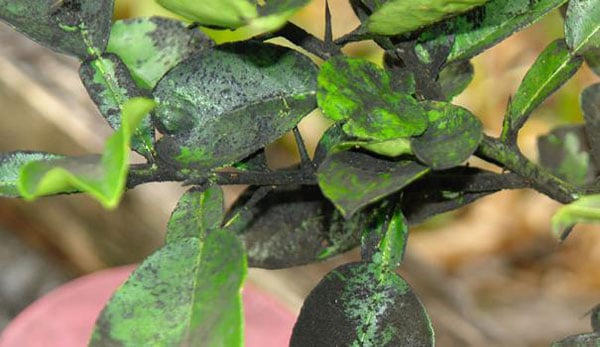
Signs of damage to aphid seedlings are identical to signs of a whitefly attack:
- leaf deformation;
- the appearance of sticky plaque;
- settlement of larvae on the inside of the leaf.
Pests can be distinguished only by the appearance of an adult:
- the wings have white wings with a yellow tint, and the aphids have a black, gray or green color;
- aphids can mask under the color of the plant;
- aphids, unlike aleirodid, have wingless individuals.
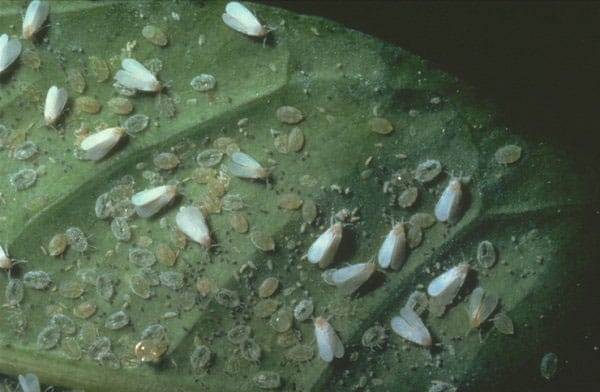
Pest Life Cycle
To make a plan how to remove a whitefly from a greenhouse and get rid of it forever, you need to get acquainted with the stages of development of this pest. The resistance or vulnerability of aleurodides to chemicals depends on the stage of their life cycle.
In total, whiteflies have three:
- egg;
- larva;
- nymph.

The development of the larva takes place in three stages. The larva of the first age (creeper) is able to actively move, during this period it intensively sucks the juices. Its color is from brown to black. Larvae of the third age are motionless, they cease to feed, become covered with a waxy substance and become nymphs.
In the egg and nymph stage, getting rid of whiteflies in the greenhouse is quite problematic. Resistance to chemicals nullifies all attempts to destroy it. It is difficult to fight adult females during egg laying. The number of treatments will need to be increased approximately twice.
Mechanical control methods - effective traps
You can save tomatoes from whiteflies and destroy adults if you fight them mechanically - make special bait traps.
Bright yellow color is attractive to aleurodides. Traps can be made independently from plywood or cardboard. Cooked slices should be painted yellow and apply a mixture of honey with rosin. For these purposes, honey or castor oil can be used. Traps attached to the holder should be placed next to the infected plant.
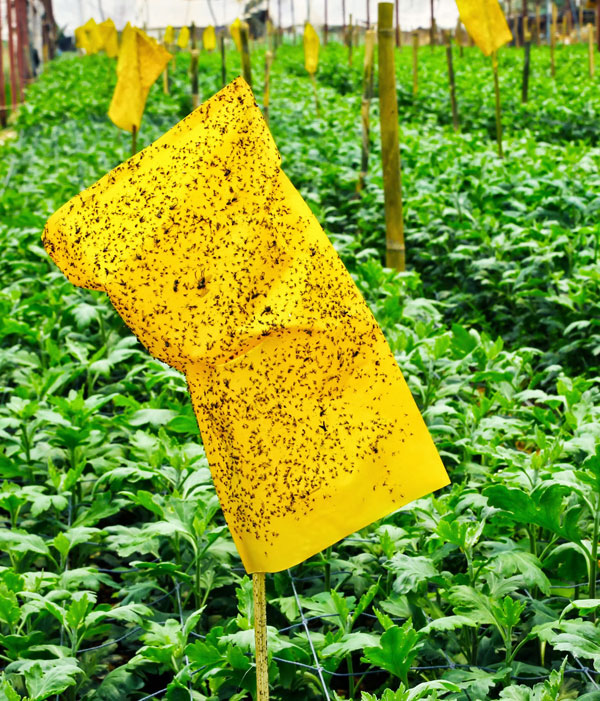
Bait traps are sold in specialized stores. They are sheets of plastic or cardboard of small sizes, covered with non-drying glue. Such traps are non-toxic, odorless and colorless; with their help it is easy to get rid of midges in any greenhouse.
Chemical attack
It is impossible to destroy insect larvae by mechanical methods, therefore, chemical action is indispensable here. For an effective fight, you need to know what the whitefly is afraid of in the greenhouse. Copper sulfate, potassium permanganate, special preparations - all these tools will help to destroy the whitefly and protect the crop from new attacks.
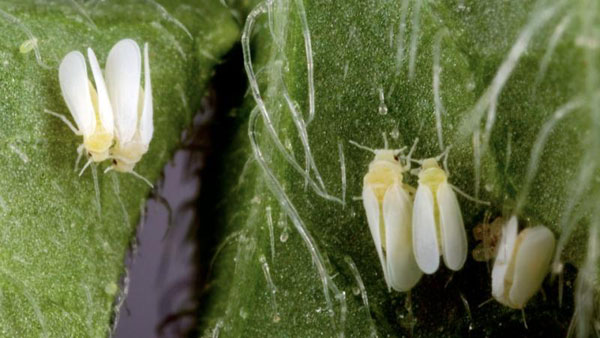
Blue vitriol treatment. The insect can hide in the upper layers of the soil, corners, small cracks. If a whitefly appeared on tomatoes or cucumbers, you can get rid of it forever in the greenhouse only with the help of complex measures.
The soil and the greenhouse itself should be treated with a solution of copper sulfate. This substance effectively fights many types of pests and at the same time fertilizes the soil.
You can use this method of disinfection no more than once every five years. Otherwise, copper will accumulate in the soil and impair productivity. This procedure can be carried out in spring or autumn, a month before planting seedlings.
Before processing the soil must be prepared:
- remove all residues of vegetation;
- thoroughly dig the earth, loosen;
- remove roots and other debris.
A solution for disinfection is best prepared from copper sulfate with the addition of lime in a ratio of 1: 1, so as not to increase the acidity of the soil.
Recommended dose of copper sulfate in the presence of pests in the soil: 200 g per 10 liters of water. With the same solution, thoroughly rinse all the surfaces of the greenhouse: walls, ceiling, frame.
Potassium permanganate disinfection. To combat aleurodides, a solution of potassium permanganate can be used. Experienced gardeners know how to get rid of whiteflies in the greenhouse with the help of this simple tool: they process the soil and the plants themselves.
This method of disinfection gives good results. Of course, it will not completely eliminate the parasite, but it is perfect as one of the components of a comprehensive fight.
For 10 liters of water you will need several grains. The solution should be slightly pinkish. With this liquid, it is necessary to spray the affected bushes of seedlings, water the soil and rinse the greenhouse.
Chemical and hormonal agents. Fighting in the greenhouse with whitefly is not complete without the use of special chemicals. All these drugs contain toxic substances: they kill the insect at all stages of the life cycle.
The following drugs give a stable and quick result:
- "Confidor." The active substance is imidacloprid. This chemical is used to spray affected plants. It provides lasting protection for 30 days. 2-3 days after spraying, it is worth treating the leaves with a mixture of 96% alcohol and water (2 tbsp. L. Per 1 liter). This measure will help to destroy the eggs: alcohol, unlike chemicals, dissolves their wax coating.
- "Aktara" - a drug that saves plants from whiteflies. The active substance is thiamethoxam. Seedlings are watered under the root. The toxic substance enters the juices that the pests eat.
- Akarin effectively destroys whiteflies. One treatment is enough to significantly reduce the number of insects.
- "Spark". Available in the form of ampoules with liquid, tablets or powder. The prepared solution is used for irrigation of leaves and watering. The drug remains effective for 25 days.
All of these drugs will help to destroy adults. To fight eggs and larvae, you need to use hormonal drugs, such as “Match”, “Admiral”.
The combination of two types of drugs - chemical and hormonal, will help to simultaneously get rid of the pest at all stages of the life cycle.
Biological methods of struggle
Chemicals are quite effective, but they penetrate into the plant. The benefits of vitamins are negated by the presence of toxic substances in the fruits.
One of the most common means of controlling whiteflies in the greenhouse is tobacco. It can be used in various ways:
- fumigation with tobacco smoke;
- use of tobacco checkers;
- spraying leaves and stems with tobacco infusion.
Nicotine can kill adult insects. During the processing of the greenhouse with tobacco smoke, drafts should not be allowed.
Modern biochemical preparations will help get rid of midges. They are created on the basis of living microflora and are absolutely safe for the future harvest:
- "Aversectin C";
- Avertin-N;
- "Bioinsecticide actophyte";
- "Bitoxibacillin."
Killing whiteflies with other insects. In industrial greenhouses, the entomophage enkarzia is often used to destroy aleurodides. This parasitic insect lays its eggs inside an adult. As it develops, the larva feeds on the tissues of a living organism. The whitefly dies, and the enkarzia larva exits.
Another insect that preys on whiteflies is the macrolofus bug. For 1 square. m will need at least five bugs that need to be released into the greenhouse every two weeks. Ladybug and lacewing help fight aleurodides.
How to get rid of whiteflies folk remedies
Whitefly can be neutralized with the help of folk remedies, some of which are also able to protect greenhouse crops from various kinds of diseases. To correctly choose how to process a greenhouse in the fall from whiteflies to achieve a positive result, it is worth trying several alternative methods at once.
Greenhouse freezing. Even if you managed to destroy all the midges and harvest, it is highly likely that they will appear again next year. Aleuridids in the form of pupae can hide on the upper layers of the soil. Its treatment with a disinfectant does not always completely destroy insects.
So that next year you do not have to look for information on how to deal with whiteflies on tomatoes in a greenhouse, you should freeze the soil and buildings.
It is known that this insect is afraid of severe frosts: it dies at a temperature of less than 10 degrees below zero. Prepare the greenhouse and freeze it according to the following scheme:
- Processing of the greenhouse in the fall from whiteflies by chemical means. The entire inside of the greenhouse is disinfected with a solution of copper sulfate, with a thorough treatment of all small cracks.
- They dig up the soil well, clean it of all plant debris - larvae and whitefly nymphs can hide on them.
- During the onset of frost, the greenhouse is kept open for at least two days. The soil inside should freeze well.
Garlic solution and other folk remedies. Small populations of aleurodides can be dealt with if the leaves are washed with warm water or a soapy solution several times a day.
The affected cultures can be treated with infusion of yarrow (100 g per 1 liter of boiling water, insist a day) or dandelion roots (80 g per 1 liter of boiling water, insist a day).
Whiteflies can be avoided in the greenhouse. Each seedling bush must be carefully inspected before planting; in the spring and autumn, preventive disinfection of soil and greenhouses is necessary.
The most effective whitefly control products in the greenhouse
Whitefly is a small moth, 1-1.5 mm in size, with a yellowish body and white wings, is very dangerous for plants and prolific. The danger to plants in the greenhouse is not only the whitefly moth itself (it is an active peddler of infections), but also its metabolic products.
Females lay a slightly yellowish, small eggs from the bottom of the leaf; they can be several hundred from one individual. After 9 days, the eggs increase in size and turn black, their larvae appear. At the initial stage of development of the whitefly larva, she has legs and antennae with which she sticks to the surface of the leaf.
The legs fall off and the insect looks like a shiny plaque-flake. After a few days, the nymph stage begins, on the sheet it looks like a transparent greenish droplet, but if you look closely, you can distinguish the red eyes.
If you do not find the source of the insect on time and do not take disinfection measures, then it will multiply in a short time to a large number
How to get rid of whiteflies in a greenhouse in autumn
To secure the harvest for next year, it is necessary to thoroughly disinfect the greenhouse before winter. Before processing the greenhouse in the fall from whiteflies, a general cleaning is done, using household chemicals. Then the surfaces are treated with bleach, copper sulfate, polycarbonate structures are washed with a manganese solution.
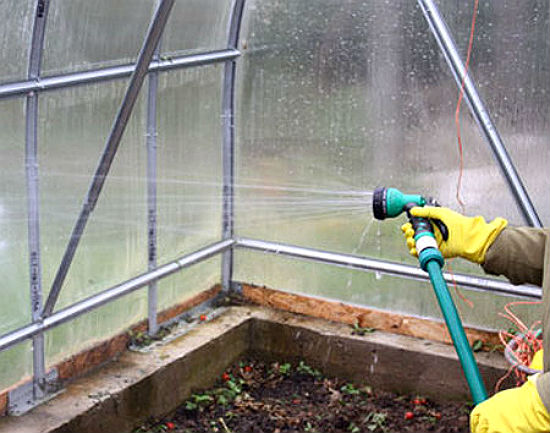
Fighting whiteflies in the greenhouse in autumn will be more effective if you smoke a room with a sulfur bomb. But such a measure will harm the greenhouse on a galvanized metal frame, so it should be treated with copper sulfate 2 times.
The soil must be poured with boiling water, covered with a dense film for steaming, the procedure is repeated 2-3 times. Then the soil is sprinkled with quicklime, dug up, spilled with a solution of copper dioxide.
From the larval stage to the adult, the insect causes serious damage to plants, weakens them, creates a favorable environment for other infections, so the question of how to deal with whiteflies in the greenhouse is relevant and paramount.
It is possible to determine the presence of whiteflies in the greenhouse by white dots on the leaves, chlorosis - a mosaic of yellow color, a shiny coating, black spots also indicate the settlement of an uninvited, harmful guest. The leaves are deformed, dry, the ovaries die.
If you do not start the destruction of the pest, then the entire crop will die. The first symptoms of whiteflies in the greenhouse should be a signal for immediate control and prevention.
Preventive measures
The whitefly in the greenhouse cannot appear from anywhere, most often it is carried by the hosts themselves with seedlings or soil. Therefore, so as not to raise the question of how to destroy the whitefly in the greenhouse, it is necessary to take preventive measures:
- New soil must be frozen, sprinkled with bleach, mix, shed with copper sulfate.
- After thoroughly cleaning and disinfecting the greenhouse in the fall, close the doors so that the insect larvae are not drifted by gusts of wind and they will not find a warm place to winter.
- Even if the polycarbonate greenhouse was treated in the fall from whiteflies, in the spring the disinfection procedure should be repeated, and the soil and surfaces should be treated with pesticides.
- Carefully inspect the seedlings, at the slightest sign of plant disease, refuse to plant them.
In the process of plant development and growth, try to maintain the correct microclimate in the greenhouse, ventilate the room in time to get rid of dampness.
These simple preventive measures will avoid the appearance of whiteflies and other dangerous diseases in the greenhouse.
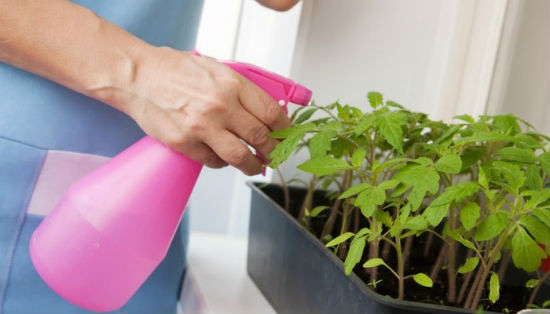
Before planting in covered ground, it is recommended to treat the plants with biological products so as not to infect the infection.
Methods of struggle
The most effective method of controlling whiteflies in the greenhouse today is to treat with chemicals and biological products.
If after the initial treatment it was not possible to remove the whitefly from the greenhouse, it is necessary to carry out a secondary disinfection, but change the preparations, since the insect quickly adapts to the active substances.
The most popular substances for controlling whiteflies in the greenhouse are Inta-Vir, Fufanol, Iskra, Actellik. The drugs are applied under the root, or dissolved in water and sprayed on plants and surfaces. In order not to harm yourself, any purchased whitefly remedy in the greenhouse must be used strictly according to the instructions on the packaging.
We will present several recommendations on how to treat a greenhouse from whiteflies, how to use the drugs correctly and in what consistency:
- Confidor is diluted in water with 0.1 ml of the drug per 1 liter. It is recommended to apply once a season.
- Mospilan add 1.05 g of water per 1 liter, used once.
- Fufanol requires 1.5 ml per 1 liter of pure water, used once.
- 2 ml of Pegasus substance per 1 liter of water, a solution for spraying is used 2 times per season, with a frequency of a week.
- Actellicum is a very effective tool for the destruction of not only adult insects, but also eggs, larvae, whitefly nymphs in the greenhouse. For spraying, 1 ampoule is dissolved in a liter of water, which is enough for 5 m2 of the treated surface. Use the tool is allowed 4 times per season.
- Verticillin is similar in action to Pegasus, but much more substance will be required for processing, approximately 25 ml per liter.
How to get rid of folk remedies
If for some reason you are forced to abandon the use of biological and chemical substances, there are effective folk methods in the fight against whitefly in the greenhouse:
- Hang glue traps, you can buy in a store or do it yourself from a bright ribbon, coating it with canola.
- Plant between the plants a ghoul, dill, which attract other insects dangerous to the whitefly moth. Insects, attracted by dill, lay their larvae in the moth larvae, destroying them.
- Fumigation of a greenhouse with smoke bombs is considered the most effective way to kill an insect.
The use of sulfur checkers is recommended for disinfection of greenhouses in autumn or spring, before planting. Tobacco checkers are harmless to plants, so they can be used at any time.
It helps in the fight against whitefly infusion of garlic, crush 5 large cloves and dissolve in a liter of water, pour into a spray bottle, thoroughly spray plants and surfaces.
Overview of all known ways to get rid of the parasite
First of all, learn to identify the first signs of a pest in a greenhouse:
- In different places of plants stickiness is felt.
- Leaves are deformed, twisted and fade.
- On the inside of the leaves you see larvae with a wax coating.
- Some leaf plates of vegetable crops are covered with yellow spots, but the borders are fuzzy.
And finally, just touch the infected bush - a whole flock of small white flies immediately rose and flew to another bush? These are definitely whiteflies. And, if you do not disdain, take a closer look at one of them - does it look like the photos below?
Let's just say: this is a serious threat to your future greenhouse harvest. And the strength of these parasites is that there are many of them - these are hundreds and thousands of small pests that literally draw all the juices from the leaves and stems. If you do nothing, then in a couple of days you will lose all your work.
Please note that if a black coating is also noticeable on the sticky secretions of the parasite, then the plants are already infected with an additional sooty fungus. Such bushes - only tear and urgently burn. Unfortunately.
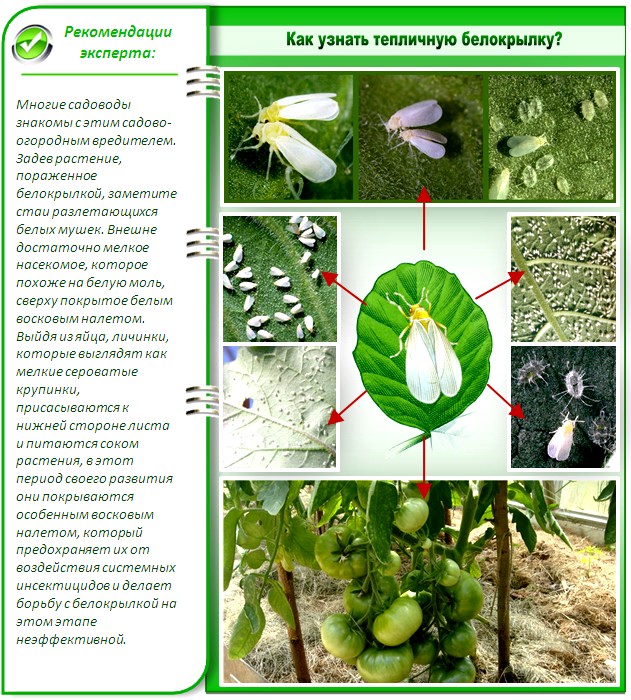
What harm does this insect do?
Another unpleasant moment that pests carry in themselves is that they consume liquids from plants in excess, and therefore emit liquid from themselves, which is especially beneficial for the development of all kinds of fungi. And what especially bothers you is that the insect still lays testicles on the lower side of the leaves.
Pest Life Cycle
Why would a seemingly ordinary summer resident know how an insect reproduces and develops? After all, we are not biologists! But it is precisely this knowledge that will help to effectively deal with this scourge: the problem is that many are trying to destroy adult individuals, while many larvae have already been left. Or vice versa. So, let's take a closer look at it.
In a word, the cocoon of this adversity is impenetrable, and if an adult appears from the pupa, the crop will be lost, because the body of the young whitefly is also covered with this wax. Then the new generation will migrate to neighboring plants and repeat its entire life cycle, while it is not difficult to guess what remains of the last bush.
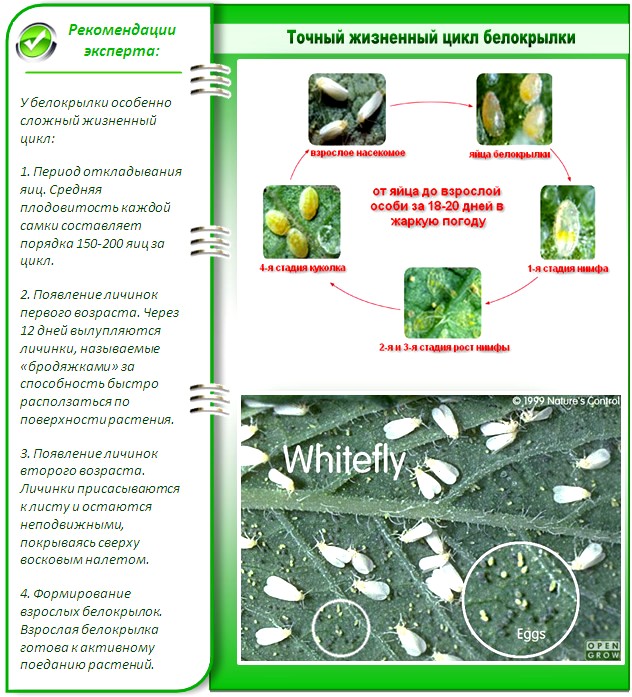
Overview of Whitefly Control Methods
So, today there are such types of struggle:
Option # 1 - mechanical methods. These are the most harmless measures. We just take and collect the insects by hand, knock them down with water from the irrigation hoses and wipe the stems and leaves with a soap solution. The latter, by the way, will also be washed off of honey dew.
Another modern method is yellow or bright blue sticky traps. On them, by the way, you will immediately see how much this muck is already in the greenhouse. Why such a color? It is the most attractive to pests. You can also hang a regular ribbon for flies - in case of emergency. But it’s better, of course, to make a quality trap:
- Step 1. Prepare petroleum jelly, thick paper, rosin and castor oil. Mix.
- Step 2. In a water bath we heat rosin and add honey, petroleum jelly and castor oil in equal parts.
- Step 3. The resulting mixture is cooled and applied to a paper base.
- Step 4. We hang ready-made ribbons throughout the greenhouse.
Ideally, if you take solid plywood for the base and paint it blue or yellow. Here it is and cover with a sticky adhesive. Has a lot of whiteflies arrived? Wash off with soap and apply again. Everything is simple!
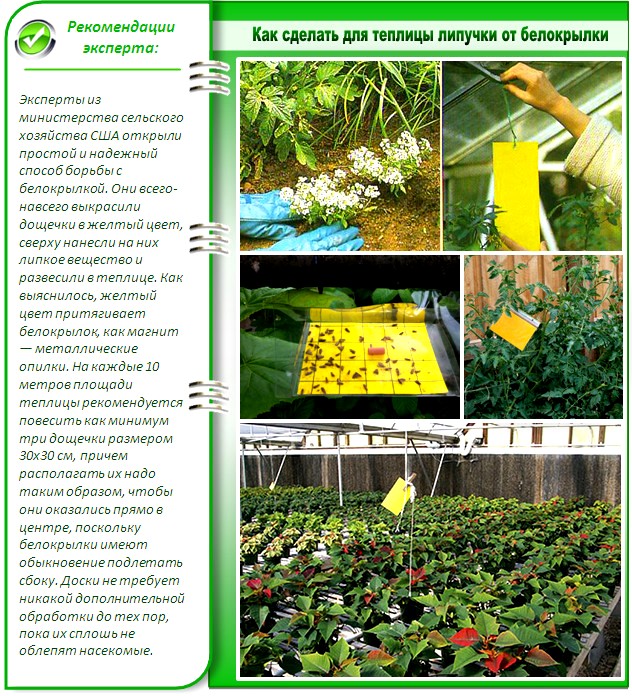
Option # 2 - biological methods. The biological method is also interesting: we will use beneficial insects. For example, lacewings and ladybugs can quickly destroy pests. Another way is to make a special herbal infusion.
Recipe number 1:
- Grind the head of garlic and fill the floor with a liter of water.
- Let us brew for about a week.
- We dilute the finished product: 5 g per 1 liter of water.
- We spray all the plants in the greenhouse.
Recipe number 2:
- We grind 40 g of dandelion rhizomes and 40 g of leaves of the same plant and fill it with 1 liter of water.
- Let us brew for a few days.
- We filter and spray the resulting solution with all the affected plants.
- After two weeks, repeat the treatment.
Recipe number 3:
- Pour 80 g of crushed yarrow leaves with one liter of water.
- We insist for two days.
- We filter and with the help of a spray we apply vegetable crops occupied by pests.
Another biological control method is to grow ... parasites for the parasite.This is done like this: we get a test tube with enkarsia and hang its contents throughout the greenhouse in small paper bags or plastic cups.
A new insect - Inc ar im. Just do not treat the greenhouse with chemicals before this. Interestingly, sometimes it’s enough to put a decorative pimju in a corner - and the whitefly also escapes!
Option # 3 - chemical methods. Of course, chemical preparations are not the best options for a greenhouse. But if it’s really bad, you have to use insecticides. Take special remedies for sucking pests: Actellik, Pyrmetrin, Malathion, Aktaru, Neudosan or Ziermetrin.
And so that the drugs stick better to the plants, add a little laundry soap to them, after rubbing it on a grater.
Especially effective is the drug Biotlin - a systemic poison from which the insect dies instantly. Good reviews in terms of combating this scourge also about KRA DEO SUPER - this is a special aerosol that needs to be sprayed all over the night.
But keep in mind that insecticides will be effective only when the insects themselves are in the imago or larval stage. You will be late - chemicals will be useless.
The most extreme case, if nothing helps at all - after harvesting, remove all the tops, disinfect the soil, and set fire to a few sulfur blocks. After that, remove the entire topsoil - this is where the larvae hide. Usually, after this, the whitefly disappears forever.
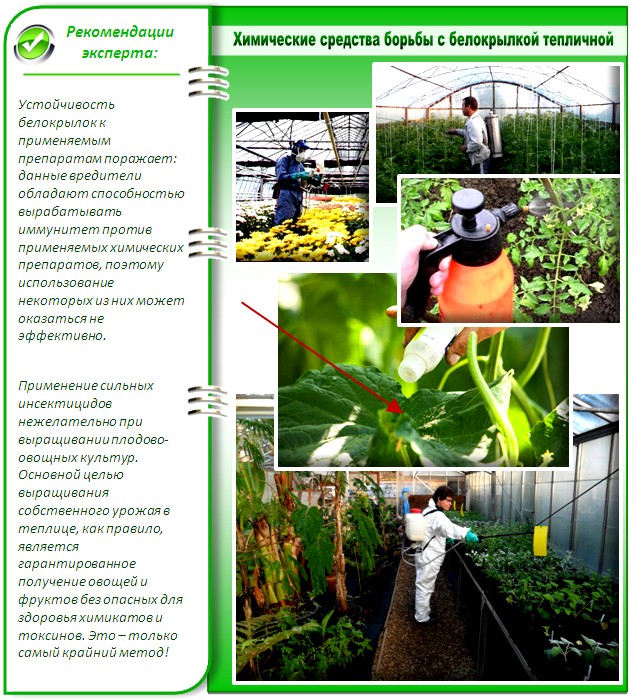
How to make an effective trap?
You can make such a cunning trap - it is unexpectedly very effective:
- Step 1. Pieces of plastic are painted in orange-yellow color.
- Step 2. Next, cover them with entomological glue.
- Step 3. We fix the backlight - directly on the plastic, which we hang at the level of the tops of the plants.
In just an hour, up to 80% of all parasites will stick to it. And put a second trap for the night:
- Step 1. In the box we drill holes at the level of the bulb - and we put it inside the box.
- Step 2. We also paint the light bulb in orange-yellow color.
- Step 3. Under the light bulb, at the bottom of the box, put a container of water.
The principle of operation of the trap is as follows: whiteflies tend to this light at night, penetrate into the box, fly, burn on a light bulb and fall into a container of water. They don’t know how to swim.
How to block the "return path" to the pest?
What to do after the pest is destroyed? Did he leave his "spies" in the closed ground? Your fears are not unfounded - and then strictly follow these rules:
- First: this is a deep digging of the entire greenhouse land - in the fall. If insects burrow into the soil - they will appear on the surface, and then the cold will finish them off.
- Second: After harvesting, always remove and incinerate all plant debris.
- Third: never place a composter directly in the greenhouse - all pests from the garden can spawn from it.
But how to make sure that this misfortune never appears at all? What preventive measures exist:
- Rule 1. For the winter, try to remove the cover from the greenhouse or remove at least the top.
- Rule 2. If the coating has not been removed, be sure to carry out spring disinfection of polycarbonate or glass, and treat the frame with bleach.
- Rule 3. Water the soil before planting with a solution of iron or copper sulfate.
Whitefly in the greenhouse: control and prevention
Very often, when growing vegetables in protected ground, summer residents are faced with a pest such as whitefly.A small insect, not more than 2 mm in size, settles in whole colonies on the inside of leaf plates grown in the greenhouse of eggplant, tomatoes, cucumbers, peppers and other cultivated plants.
Whiteflies are a serious threat to most tender vegetable crops growing in greenhouses. The main danger lies in the huge colonies of insect pests. Sucking out all the juices from young stems and leaves, they are able in a few days to nullify all the work of summer residents and leave them without a long-awaited harvest.
Greenhouse Whitefly Life Cycle
Whitefly belongs to sucking pests of cultivated plants. The insect is small and resembles aphids, with only one difference - the white color of the body. He prefers to settle in large groups on young shoots and leaf plates, where it is easy to eat plant juice.
The inside of the leaves is a great place to lay eggs. In the subsequent of them, larvae appear that are able to move independently in search of tender areas of the plant necessary for nutrition.
Their body is enveloped by a wax coating. During this period, under the reliable protection of the formation of an adult insect. After exiting a kind of cocoon, the pest is firmly fixed on the plants, and they begin to actively drink juice. Moreover, his body is still reliable, protected by a wax coating.
Subsequently, the grown generation of whiteflies migrates to neighboring plants and the life cycle of the pest is repeated again. It is worth noting that insects consume more juice than they require. All excess nutrient fluid is excreted from the body by "honey dew", which is a fertile environment for the development of many fungal diseases.
Signs of occurrence
whiteflies in a greenhouse
To determine whether whiteflies are quite easy in the colony greenhouse. To do this, you need to know the following signs of their appearance:
- When in contact with plants, many small and white insects rise into the air;
- Leaf plates of vegetable crops are covered with specific yellow spots with fuzzy borders;
- Appearance of sticky spots in places where insects feed;
- Deformation, twisting and wilting of leaves;
- The presence on the inner side of the leaves of the larvae covered with a wax coating.
The appearance of black plaque on sticky secretions indicates infection of the cultivated plant with soot fungus. In this case, the affected bushes must be removed and burned.
Prevention
In order to prevent harmful insects from appearing in the greenhouse, and indeed in the garden, you need to start with preventive measures. What exactly needs to be done by a summer resident concerned about the appearance of whiteflies on cultivated plants?
- Deep digging of the soil in late autumn. This will allow insects buried in the winter to rise to the surface. And then the cold will do its job.
- Remove and burn all plant debris after harvest.
- Do not place the composter directly on the site. That it can become the main wintering place not only for whiteflies, but also for other pests of the garden.
- Compost heaps are best to equip not the boundary of the site, away from the main beds and plants.
As for the preventive work against whiteflies in the structures of the protected ground, it is appropriate to include the first two points from the above. And also add a few more separate, according to the autumn preparation of the greenhouse:
- If the construction of the structure allows, then for the winter it is necessary to remove the polycarbonate coating.
- If this is not possible, disinfect the coating.
- Be sure to clean and process the greenhouse frame with bleach.
- Disinfect the soil with a solution of iron or copper sulfate.
If all these measures cannot be performed, then you will have to be patient and proceed to the systematic destruction of insects during the season. All methods of controlling whitefly can be divided into several categories:
- Mechanical methods of struggle;
- Biological methods of destruction;
- Fight with insecticides and chemicals.
Mechanical methods
Removing whiteflies mechanically is one of the most harmless measures. What are many summer residents usually doing here?
- Insects can be collected from plants manually.
- Watering hoses can be used to knock them down.
- If there are not many plants, then you can wipe their stems and leaf plates with a soap solution.
By the way, the last two options allow you to get rid not only of the pest, but also of the honey dew secreted by it in the process of feeding. In this case, vegetable crops will become much easier. But all these are temporary measures.
You can’t catch all the insects with your hands. And those who were hit or washed away by a stream of water, after some short time, return again to the place of their feeding.
The most effective mechanical method for removing whiteflies from the greenhouse is the use of special adhesive traps. Their use will also allow you to judge the severity of the problem in your greenhouse.
Such a gamut is considered attractive to insect pests. And to everything, against its background it is very convenient to judge the degree of damage to cultivated plants. Many use fly tape. She also does a good job of her task.
If you are not lazy, then such a device can be made independently. To do this, you need the following materials:
- Thick paper (parchment possible);
- Castor oil;
- Rosin;
- Vaseline.
Further, in the manufacture of traps for whiteflies, you should melt the rosin in a water bath and add castor, petroleum jelly and honey in equal proportions. Stir it all and cool. After that, the prepared sticky composition can be applied to the base, which is hung throughout the greenhouse.
Of course, such a tool can be used once. For reuse of the glue trap as a basis, you can use thick cardboard, or better plywood squares.
They should be painted in bright colors (yellow or blue) and after drying coated with adhesive composition of their own production. As they are filled with whiteflies, the traps are washed with soap and water and the composition is applied again.
Biological control method
The biological method of control can be attributed to the use of beneficial insects. For example, ladybugs and lacewings. Only a few of these predators can destroy a huge number of whiteflies. We mentioned how to attract these insects in an article on leaf gall aphids on currants.
Another way to combat biological orientation is the use of infusions from certain herbs and cultures. Here are some useful recipes.
Garlic infusion against whiteflyIngredients:
- Head of garlic;
- Half a liter of water.
Garlic is chopped and poured with water. Then let it brew for a week. The finished product is diluted based on 1 liter of water 5 grams of infusion. And with this solution all plants in the greenhouse are sprayed.
Dandelion Flask. Ingredients:
- Dandelion rhizomes - 40 grams;
- Dandelion leaves - 40 grams;
- Water - 1 liter.
Rhizomes and leaves must be chopped and filled with water. Let it brew for several days. Then you can strain the finished infusion and spray it with plants affected by insects. Reprocessing can be done after two weeks.
Yarrow herb infusion. Ingredients:
- Water - 1 liter;
- Shredded yarrow leaves 80-90 grams.
Prepared raw materials are poured with water and infused for about two days. After the infusion is filtered and with a sprayer is applied to vegetable crops occupied by whiteflies.
Use of insecticides
The use of commercially available chemicals is recommended in cases of a large number of whiteflies, when the use of other methods does not give any effect. It is best to purchase products that are designed to combat sucking pests. These include:
- Actara;
- Malathion;
- Pymethrin;
- Actellik;
- Unsound;
- Cypermethrin.
For the best adhesion of drugs to plants, a small amount of grated laundry soap can be added to the prepared solution.
How to get rid of whiteflies in a greenhouse
Last season, tired of destroying whiteflies. Used several folk remedies (garlic infusion, a solution of laundry soap, yarrow broth), sprayed with chemical preparations (Commander, Spark). The effect was, but short-lived.
The leaves are covered with black coating, photosynthesis in them is significantly reduced. In addition, almost all sucking insects are carriers of viruses.
It's hard to get rid of, but you can. For a successful fight you need to know:
- development cycle
- the conditions under which pests reproduce easily,
- approved drugs, as well as which stage of the insect they affect,
- how to treat the soil in the greenhouse before the start of the new season.
What is an insect and how does it develop
This pest belongs to the order of homoptera (Homoptera), the family of whiteflies (Aleyrodidae). Visually, insects are perceived as small white butterflies. The imago does not exceed 1.5 mm in length. They have two pairs of narrow wings with a slight coating of hairs, on the front you can see two longitudinal stripes.
Larvae of 1-3 orders of magnitude are immovable, oval-elongated, gray-white or yellowish, with red eyes. There are no wings; there are spines on the body. This stage lasts about two weeks. 4th order larvae are covered with wax-like substance and acquire the ability to move. The next stage is the imago, which is already capable of procreation.
The life expectancy of adults depends on the plants that feed on insects, for example, on tomatoes for 14 days, on cucumbers 19, and on eggplants 35. The average duration of development from larva to imago is 25 days, i.e. Up to 12 generations of the pest can develop in heated greenhouses per year.
How to significantly reduce active whitefly propagation
Ideal conditions for whitefly propagation are: air temperature over 22 degrees and high humidity (more than 65%). If the above conditions are maintained in the greenhouse for a long time, then the development of larvae and nymphs is significantly reduced, as a result, the number of whiteflies increases exponentially.
In large greenhouse farms, specific insects are used in the fight against whitefly: enkarzia or macrolofus.
For connoisseurs of beauty, it is recommended to plant fragrant martinia, called the devil's claw due to the specific form of ripening fruits. The plant is distinguished by the fact that it is able to digest the little things adhered to the leaves. This is an annual of African origin. It makes sense to grow seedlings and plant them in a greenhouse, but not in the shade of cultivated plants.
The use of chemical and biological preparations
All synthetic and biological preparations against whiteflies can be divided into 2 groups:
- cause mortality of adults by about 90%, but do not affect larvae. These include Aktara, Actelik, Confidor, Fitoverm, Talstar, Vermiteks, Pegasus, etc.
- destroy larvae, but practically do not affect adults. These include Match, Spintor, Admiral, Mospilan, etc.
Based on the above, it follows that the use of various drugs must be considered. If several flying individuals are found, it makes sense to spray Aktara, whose protective effect lasts up to 20 days.
If the pest has multiplied so much that various stages have appeared, then it will have to be treated with a combination of drugs. After 5-6 days, a second treatment will be needed (no drugs act on the nymphs), it is better with another combination. A third spray is often required.
Preparing the greenhouse for the new season
If last year a whitefly “operated” in a greenhouse, then the soil must be treated with bleach before the season begins. At the end of the season, do not leave plant debris in and around the greenhouse, but remove and burn them.
It should be borne in mind that plants in open ground can be affected by a whitefly from a greenhouse. It’s easier to deal with the pest in the open air, because conditions for reproduction are not entirely suitable, and the “immunity” of non-greenhouse plants is higher.
leave a comment